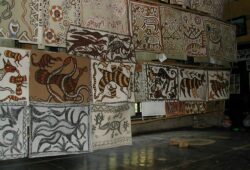Michelangelo’s Masterpiece: The Sistine Chapel Ceiling Painting
 Posted On
Posted On
The Sistine Chapel ceiling, adorned with Michelangelo’s awe-inspiring frescoes, stands as an enduring testament to human artistic achievement. This iconic masterpiece, located within Vatican City, continues to captivate visitors from around the world with its intricate details, powerful narratives, and sheer grandeur.
Commissioned by Pope Julius II in the early 16th century, Michelangelo Buonarroti embarked on a monumental task that would become one of his most celebrated works. The Sistine Chapel’s ceiling spans an area of over 5,000 square feet, offering an expansive canvas for Michelangelo’s artistic genius. The project was a feat of both physical and creative endurance, taking four years to complete from 1508 to 1512.
The ceiling’s central panels depict scenes from the Book of Genesis, a selection of episodes from the creation story and the stories of Adam and Eve. Michelangelo’s unparalleled skill in human anatomy and perspective is evident in the muscular forms and lifelike gestures of his figures. The Creation of Adam, perhaps the most famous segment, portrays the moment when God reaches out to bestow life upon Adam with their fingers almost touching—an image that has become emblematic of divine inspiration.
One of the most remarkable aspects of Michelangelo’s work on the Sistine Chapel ceiling is his innovative approach to fresco painting. He utilized a unique technique, called “buon fresco,” in which pigments are applied onto wet plaster. This allowed the colors to become an integral part of the plaster as it dried, ensuring the longevity of the artwork. The process required precision and swiftness, as Michelangelo had to complete each section before the plaster dried.
The complex iconography of the ceiling extends beyond the central Genesis scenes. The corners of the ceiling are adorned with the ancestors of Christ, conveying a sense of continuity between the Old and New Testaments. Additionally, the lunettes—small, semi-circular spaces above the windows—are adorned with paintings of biblical prophets and sibyls, each foretelling the coming of Christ and offering a harmonious blend of classical and religious themes.
Despite the passage of centuries, the Sistine Chapel’s ceiling remains a testament to the timelessness of human creativity. The painstaking restoration efforts carried out in the late 20th century revealed the brilliance of Michelangelo’s original palette, which had been obscured by centuries of dirt and soot. This restoration not only revitalized the colors but also enhanced our understanding of the artist’s techniques and intentions.
Visiting the Sistine Chapel is a transformative experience. As one gazes upward at the intricate details of the painted ceiling, a sense of awe and wonder fills the air. The interplay of light and shadow, the vivid hues, and the sheer scale of the artwork leave an indelible mark on those fortunate enough to witness it in person.
In conclusion, Michelangelo’s Sistine Chapel ceiling painting stands as a testament to the power of human creativity, perseverance, and artistic innovation. Its intricate narratives, masterful technique, and spiritual significance continue to inspire and captivate audiences across the globe. The ceiling remains an enduring symbol of the harmonious union between art and spirituality, a testament to the boundless possibilities of human expression.



